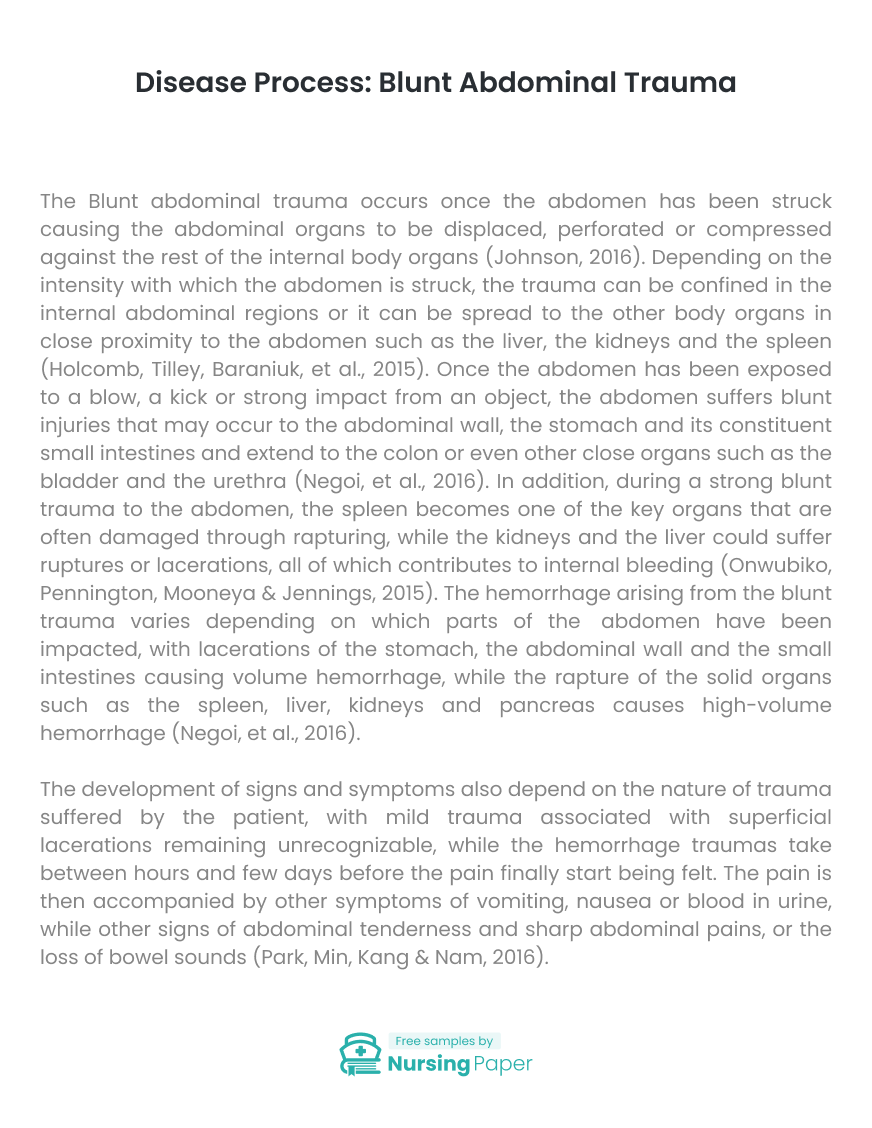
Introduction
The Blunt abdominal trauma occurs once the abdomen has been struck causing the abdominal organs to be displaced, perforated or compressed against the rest of the internal body organs (Johnson, 2016). Depending on the intensity with which the abdomen is struck, the trauma can be confined in the internal abdominal regions or it can be spread to the other body organs in close proximity to the abdomen such as the liver, the kidneys and the spleen (Holcomb, Tilley, Baraniuk, et al., 2015). Once the abdomen has been exposed to a blow, a kick or strong impact from an object, the abdomen suffers blunt injuries that may occur to the abdominal wall, the stomach and its constituent small intestines and extend to the colon or even other close organs such as the bladder and the urethra (Negoi, et al., 2016). In addition, during a strong blunt trauma to the abdomen, the spleen becomes one of the key organs that are often damaged through rapturing, while the kidneys and the liver could suffer ruptures or lacerations, all of which contributes to internal bleeding (Onwubiko, Pennington, Mooneya & Jennings, 2015). The hemorrhage arising from the blunt trauma varies depending on which parts of the abdomen have been impacted, with lacerations of the stomach, the abdominal wall and the small intestines causing volume hemorrhage, while the rapture of the solid organs such as the spleen, liver, kidneys and pancreas causes high-volume hemorrhage (Negoi, et al., 2016).
The development of signs and symptoms also depend on the nature of trauma suffered by the patient, with mild trauma associated with superficial lacerations remaining unrecognizable, while the hemorrhage traumas take between hours and few days before the pain finally start being felt. The pain is then accompanied by other symptoms of vomiting, nausea or blood in urine, while other signs of abdominal tenderness and sharp abdominal pains, or the loss of bowel sounds (Park, Min, Kang & Nam, 2016). The onset of the symptoms then leads to the rise of abdominal rigidity that is created by the guarding reaction seeking to tense the muscles and tissues of the abdomen to ensure that the inflamed internal abdomen organs have been shielded (Johnson, 2016).


The continued bleeding of the internal abdominal organs leads to the collection of a pool of blood within the retroperitoneal abdominal space, creating the serious risk of mortality by causing tissue edema (Holcomb, Tilley, Baraniuk, et al., 2015). The elevated edema of the abdominal tissues in turn increases the abdominal pressure, resulting in both high intensity pains and the dysfunction of the close proximity vital body organs. The rise in the abdominal pressures results in interfered respiration in the liver while at the same time decreasing the venous returns to the cardiovascular system, thus risking the patient suffering from hypotension (Onwubiko, Pennington, Mooneya & Jennings, 2015). The central nervous system may also become affected in the course of the low venous returns that hinder drainage from the brain, thus risking the patient suffering from CNS injuries.
On the other hand, the perforations of the small intestines, the colon or the bladder results in inter-abdominal infections, while the rupture of the bile during the incidence of liver perforation creates the biliary leakage that also increases the risks of infection of the internal abdominal organs (Park, Min, Kang & Nam, 2016). The blood and bowel hemorrhage and their associated infections become the primary causes of mortality for patients affected by blunt abdominal trauma, if the gastrointestinal and internal organ hemorrhages are not addressed in good time.
1. Holcomb, J., Tilley, C., Baraniuk, S., et al. (2015). Transfusion of plasma, platelets, and red blood cells in ratio and mortality in patients with severe trauma. JAMA 313(5), 471-482.
2. Johnson, S. B. (2016). Pathophysiology and management of abdominal injury. Critical Care 2, 36-47.
3. Negoi, I. et al. (2016). Latest progress of research on acute abdominal injuries. Journal of Acute Disease 5(1), 16-21.
4. Onwubiko, C., Pennington, E., Mooneya, D. & Jennings, R. (2015). Intestinal perforation due to minor blunt abdominal trauma–a harbinger of underlying disease pathology. Journal of Pediatric Surgery Case Report 3(1), 35-37.
5. Park, J., Min, J., Kang, J. & Nam, Y. (2016). Massive Hematochezia Following Blunt Trauma in a Patient with Crohn’s Disease: Intraluminal Bleeding without Hemoperitoneum. Chin Med J (Engl) 129(2), 246–247.



The download will start shortly.

The download will start shortly.
 Subject:
Medicine
Subject:
Medicine  Number of pages: 2
Number of pages: 2  Subject:
Medicine
Subject:
Medicine  Number of pages: 3
Number of pages: 3  Subject:
Medicine
Subject:
Medicine  Number of pages: 2
Number of pages: 2  Subject:
Medicine
Subject:
Medicine  Number of pages: 2
Number of pages: 2  Subject:
Medicine
Subject:
Medicine  Number of pages: 5
Number of pages: 5  Subject:
Health and Social Care
Subject:
Health and Social Care  Number of pages: 3
Number of pages: 3  Subject:
Medicine
Subject:
Medicine  Number of pages: 2
Number of pages: 2  Subject:
Nursing
Subject:
Nursing  Number of pages: 6
Number of pages: 6  Subject:
Medicine
Subject:
Medicine  Number of pages: 2
Number of pages: 2  Subject:
Medicine
Subject:
Medicine  Number of pages: 1
Number of pages: 1  Subject:
Medicine
Subject:
Medicine  Number of pages: 4
Number of pages: 4  Subject:
Health and Social Care
Subject:
Health and Social Care  Number of pages: 7
Number of pages: 7  Subject:
Health and Social Care
Subject:
Health and Social Care  Number of pages: 4
Number of pages: 4  Subject:
Health and Social Care
Subject:
Health and Social Care  Number of pages: 11
Number of pages: 11 
